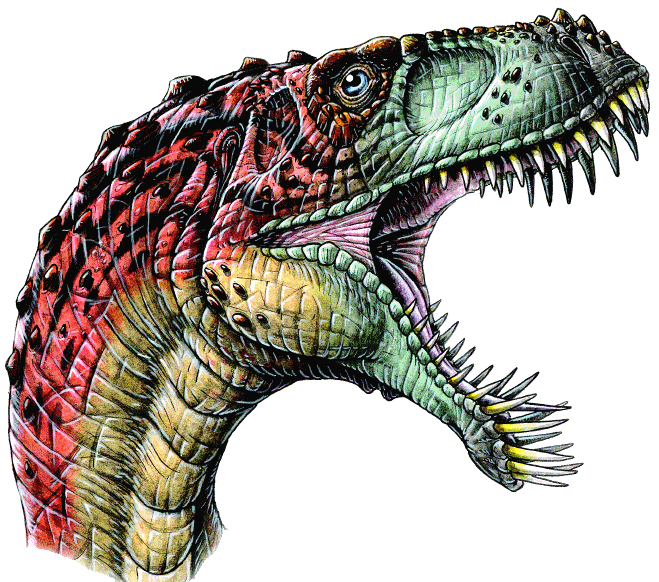|
||||||||||||||||||||
|
Masiakasaurus was a
very strange looking dinosaur from Madagascar..
It had a long neck and tail, walked on two feet,
and weighed about as much as a German shepherd, but is most unique
characteristics is its front teeth. They stuck almost straight out from the front
of its mouth. This dental feature has been found on some flying
reptiles, but this is the first time that it has been found on a
dinosaur. The discovery was announced in January of 2001in the journal Nature this week by a team of researchers led by paleontologist Dr. Scott D. Sampson of the University of Utah. Additional authors on the paper are Dr. Matthew T. Carrano and Dr. Catherine A. Forster, both from the State University of New York at Stony Brook. The fossils consist of a number of isolated bones from several individuals, most recovered from a single site. Included in the collection are parts of the jaws and about 40% of the remainder of the skeleton, with some bones represented by multiple examples. The uniqueness of the teeth was immediately apparent. “When we dug up the first lower jaw bone, we weren’t even sure it belonged to a dinosaur,” said Sampson. "It was only after we compared it with the lower jaws of other carnivorous dinosaurs that we became convinced as to the nature of the owner. Certain features at the back of the jaw are unmistakably theropod." Theropods are the group of meat-eating dinosaurs that included Tyrannosaurs and Velociraptor. "The lower front teeth are nearly horizontal, with the teeth angle increasing until the dinosaur’s fourth tooth, after which the teeth are vertical. Although the back teeth of the dinosaur are similar to other predatory dinosaurs, their horizontal, conical front teeth are otherwise unknown among other (predatory) dinosaurs.” One sharp-witted dinosaur enthusiast remarked that the dinosaur really need a good orthodontist. Masiakasaurus habits are a mystery. There are a few species of living mammals with similar dental features and they may provide some clues. These animals include various shrews and a group of South American marsupials known as caenolestids. These mammals also have elongate, conical, forward-projecting teeth up front. In virtually all cases, the front teeth are used for grasping and piercing rather than tearing and slicing, and the prey generally consists of insects. The jaws of Masiakasaurus suggest a similar feeding strategy, with the front teeth used to capture and manipulate animal prey, and the blade-like rear teeth then slicing and tearing the victim into bite-sized chunks. As to the nature of the preferred prey of this little dinosaurian carnivore, potential candidates include insects, fish, lizards, snakes, and mammals. The name of the new dinosaur is derived from masiaka, the Malagasy word for “vicious” and sauros, which is Greek for “lizard.” Knopfleri honors musician Mark Knopfler, lead singer of Dire Straits. According to Scott Sampson, the band's music was a 'talisman' for the research team: whenever they played it, they'd find another fossil. Literally translated, it means "'Vicious lizard of Knopfler". Madagascar is the fourth largest island in the world. It is located more than 500 miles off the southeastern coast of Africa. Today it is well known for being home to some of the world's most unusual animals, the great majority of which are highly endemic (that is, known only from Madagascar). 70 million years ago. It was inhabited by such weird critters as a pug-nosed, land-dwelling, plant-eating crocodiles, flying raptors, giant, thick-skulled carnivorous dinosaurs and two unique carnivorous dinosaurs. The area then seems to have been cosmopolitan. In other words, the animals preserved in the Late Cretaceous of Madagascar closely resemble those found on other southern hemisphere continents. In addition, it appears that the ancestors of modern Malagasy animals had not yet arrived by the Late Cretaceous, suggesting that they reached Madagascar following its isolation as an island. Masiakasaurus is one of two thick-skulled carnivorous dinosaurs found on Madagascar. Both it and its' larger cousin Majungatholus are members of an enigmatic group known as abelisaurids, which have only been recovered from the Southern Hemisphere. The fossils of Masiakasaurus share a number of specialized characteristics with predatory dinosaurs found in Argentina and India and indicate that small-bodied predatory dinosaurs spread out across much of the Southern Hemisphere toward the end of the Age of Dinosaurs. Madagascar was once part of the southern supercontinent Gondwana, which began to break up the heyday of dinosaurs around 140 million years ago. Together with fossil evidence that the larger abelisaurids theropods also spread out over the Southern Hemisphere in the Late Cretaceous, this most recent finding supports a recently proposed theory that Gondwanan landmasses retained connections much longer than previously thought. "If so", Sampson said, "then dinosaurs and other land animals may have been able to travel the vast distances between South America and India-Madagascar because the two regions remained connected via intervening land masses." |
||||||||||||||||||||
|
||||||||||||||||||||
